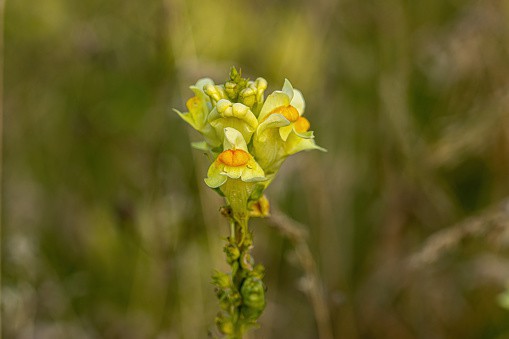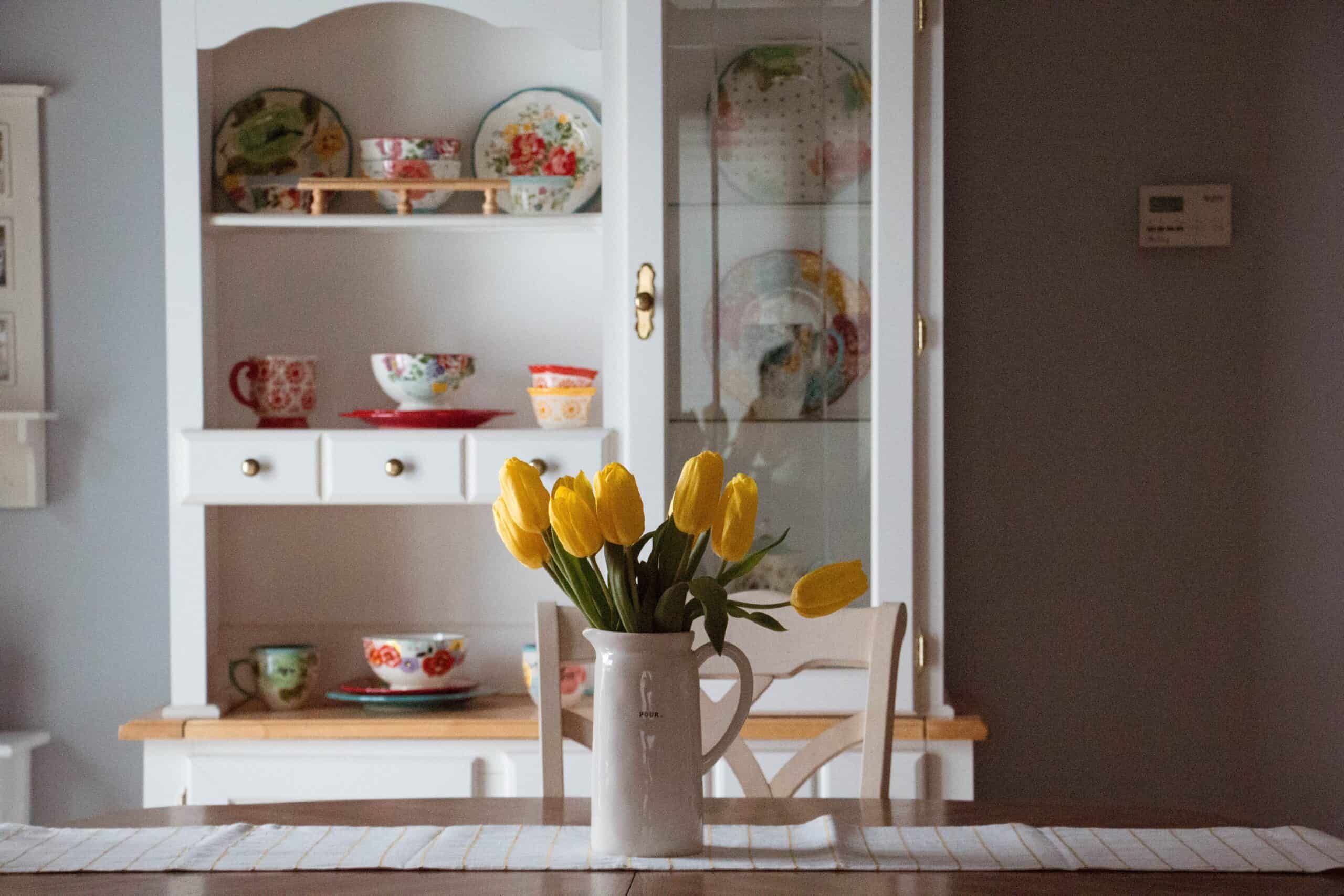The Linaria Vulgaris, also called Yellow Toadflax, is part of the Plantaginaceae family. It is a perennial with upright-forming stems and profuse yellow and white flowers. The blooms are similar to Snapdragons and appear in late spring, lasting until the first frosts arrive. It is often labelled as a weed and can spread quickly, which is why it is also listed on the poisonous plant database. With the right gardeners’ touch, though, it can provide a beautiful ornamental display when planted in full sun.
Etymology
The Latin word “Linaria” is derived from the Latin word ‘linum’, meaning flax, which is due to the similarities between flax fibres and the delicate leaves of this plant. The species name ‘Vulgaris’ is Latin for ‘common’, as the plant is widespread in its native regions of Europe, North Africa and southwestern Asia. It has been popular for decades as bedding and border plants in gardens and among florists.
How to Plant
When it comes to planting the Yellow Toadflax, it should be done in the early fall when planting new plants. To ensure the plant’s full growth potential, it is best to plant them in a sunny spot with a well-draining soil; they cannot be grown in heavy clay or soggy soil. If you plan to grow them in a pot or container, use potting soil and lightly sprinkle a slow-release fertilizer on top. The pot should be placed in an area that gets about 6 hours of direct sunlight a day. The soil should be kept moist, but not wet; over-watering may cause root rot.
Meaning and Symbolism
Linaria Vulgaris is most commonly known as the Symbol of Liberty due to its long history as a symbol of freedom in Europe, with the French Revolution being particularly noted for its association. Considering its notoriety of being an emblem of freedom and justice, the flower is perfect for the gardener who is passionate about their freedom. It’s also said to impart courage and strength to those who think on its symbolism throughout the day.
The old common name “Wild Balsam” is derived from the Latin family name for the species, BALSAMINACEAE. It’s also known as Bunny’s Ears and Butter-and-Eggs due to the bright yellow and white petals of the flower.
History, Mythology, and Religious Significance
In the 18th century, Yellow Toadflax was well known to be used as an ornamental flower in gardens across France. It was an important plant in the coat of arms of former French kings and was carried in procession for the coronation of Napoleon. It has also been used as a medicinal herb to treat indigestion, sore throat and other illnesses.
In Hellenic mythology, Linaria Vulgaris was said to be the favourite flower of Hades, ruler of the Underworld. It is said to symbolize wishing and hope, due to its long-lasting blooms. Many believe that this flower provides guidance and strength, while some associate it with bad luck or tragic events.
Linaria Vulgaris is also said to be a symbol of rebirth in many religions. It is often associated with central and northern India religions, which recognize it as a sacred flower and use it in rituals and worship. In Christianity, Yellow Toadflax is known to denote bereavement and recall memories of those who have passed away.
Flower Varieties and their Characteristics
The species’ Linaria Vulgaris is a part of a large genus, producing several colorful and hardy variations. These hybrids in particular stand out from the rest:
- ‘Majestica Yellow’: This variety features strong yellow flowers with contrasting ruby spots and grows to about 24 inches tall; perfect for small spaces.
- ‘Heavenly Blue’: This beautiful variety boasts small, star-like petals in soft shades of blue and lavender, and it grows to 12 inches tall.
- ‘White Giant’: As its name suggests, this hybrid bears white blooms and reaches 24 to 36 inches tall.
- ‘Naked Lady’: This variety has a unique allure, featuring large, white petals and no stem, making it appear as if the flower blooms right out of the ground. It is 15 to 18 inches tall.
How to Pot and Repot
When selecting a pot for Yellow Toadflax, chose one that is one size larger than the original pot. This type of plant prefers a small, shallow container, about 6-7 inches in depth. Fill it up with a potting mix that drains fast enough and use a slow-release fertilizer for more nutritious soil.
To repot the plant, you will need to carefully remove it from the original pot. Remove any dead roots and loosen the soil around the rootball. Place the plant in a larger pot with a mix that is nutrient-rich, and ensure to leave at least 1-2 inches of space between the roots and the sides of the pot. Gently press on the soil and provide the plant with adequate watering.
How to Prune
Yellow Toadflax is a fast-growing plant which requires regular pruning to maintain shape. When it comes to pruning, it is best to do it in winter while the plant is dormant. This can be done by removing dead stems and branches from the base. For general pruning and shaping, trim the tips of the stems back to the desired length. This will promote bushier growth and encourage more luscious blooms.
How to Propagate
To propagate Yellow Toadflax through seed, begin by soaking the seed in room temperature water overnight. Once the seed has soaked, select some potting soil or other suitable soil mix and sprinkle the seeds on the surface. Lightly mist the soil with warm water and then lightly cover with a layer of soil. Cover the pot with plastic wrap to retain moisture and place it in an area where the temperature is around 65-75°F (18-24°C). The seeds should take up to a month to germinate. Thin out the seedlings once the sprouts reach about 3-4 inches tall.
Common Pests and Diseases
The most common pests associated with Yellow Toadflax are aphids, mealybugs, and thrips, which usually occur during the summertime. Powdery mildew can be a threat, so try to avoid getting the plant too wet or overcrowding it with other plants. Discoloration of the foliage may also occur; this could be due to overwatering or a lack of nutrients in the soil. In this case, prune away any affected foliage and perform a nutrient-rich fertilization.
Questions and Answers
Question 1: Is the Yellow Toadflax flower poisonous?
The Yellow Toadflax is not known to be poisonous to humans or animals, but it is considered toxic to some livestock. It is also listed on the poisonous plant database as it is considered to be an invasive species.
Question 2: How often should I water the Yellow Toadflax?
The Yellow Toadflax should be watered two to three times a week when the soil is dry to the touch. Too much water can cause fungal diseases, so make sure the water drains well and do not overwater.
Question 3: How long does the Yellow Toadflax bloom for?
The Yellow Toadflax typically blooms from late spring to the first frosts. With the right care, the flowers can last up to three weeks with regular deadheading.
Facts Sheet
| Yellow Toadflax | Linaria Vulgaris |
| Family | Plantaginaceae |
| Plant Type | Perennial |
| Mature Size | 3-5 feet tall |
| Sun Exposure | Full Sun |
| Soil Type | Well-draining |
| Soil pH | 6.5-7.0 |
| Bloom Time | Late Spring |
| Flower Color | Yellow and White |
| Hardiness Zones | 3-9 |
| Native Area | Europe, North Africa, and Southwestern Asia |
What we love from Amazon this week
Buy these wonderful flowers directly from Amazon:















